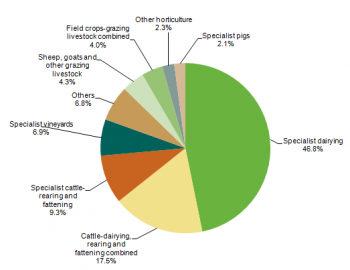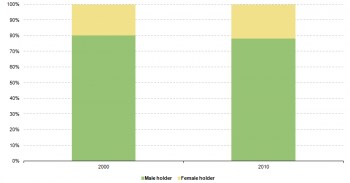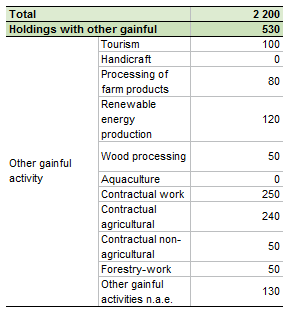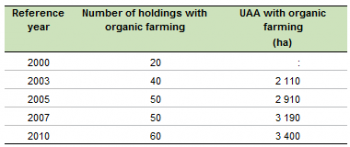Archive:Agricultural census in Luxembourg
This article has been archived.
This article is part of a series of country-specific essays on the results of the European Union (EU) Farm structure survey (FSS) 2010. The FSS collects information on the structural characteristics of agricultural holdings (land use, livestock and labour force) and is carried out by all European Union Member States every 10 years as an Agricultural census, with two or three additional, intermediate sample surveys carried out in-between. The present analysis of the farm structure includes a comparison with the FSS 2000.
In Luxembourg, the FSS 2000 and the Agricultural census 2010 were carried out using different thresholds[1]. To overcome this methodological issue for the present article, the 2000 values were filtered using the 2010 thresholds. Accordingly, the 2000 figures mentioned throughout this article and presented in the tables, or available through hyperlinks, differ slightly from those presented in the Eurostat online database. Nonetheless, hyperlinks to the online database are also provided throughout the article.

Source: Eurostat (ef_kvaareg) (ef_ov_kvaa) (demo_pjan) and FSS 2000 and 2010

Source: Eurostat (ef_kvaareg) (ef_ov_kvaa)

Source: Eurostat (ef_kvftreg)

Source: Eurostat (ef_kvftreg)

Source: Eurostat (ef_lu_ovcropaa) (ef_oluaareg)

Source: Eurostat (ef_lu_ovcropaa) (ef_oluaareg)

Source: Eurostat (ef_mptenure)

Source: Source: Eurostat (ef_pmhouscatlaa)
Main statistical findings
Key indicators
Among the European Member States, Luxembourg had the smallest number of agricultural holdings (2 200) in 2010, with Malta (12 530) having the second lowest number. Over the 2000-2010 timeframe, 540 farms ceased their activities as there were 2 740 holdings in 2000 (see Table 1). The utilised agricultural area (UAA) experienced the opposite trend, increasing from 127 400 hectares in 2000 to 131 110 hectares in 2010 (+2.9%). This equated to about half of the country’s territory in 2010, one of the highest proportions recorded within the EU-28.
As a result of the number of holdings decreasing and agricultural land area increasing, the average holding size increased from 46.5 hectares per farm in 2000 to 59.6 in 2010. Compared with other EU Member States, this was quite a large average area; the average area per holding was also similar in Germany (55.8 ha/farm) and Denmark (62.9 ha/farm).
As widely observed across the EU-28, Luxembourg also encountered a decrease in the number of people regularly working on farms, falling by 21% since 2000 to 4 960 workers in 2010. This agricultural workforce represented only 2.1% of the Luxembourgish active population[2] in 2010, one of the lowest proportions among the EU Member States.
The farm animal population, expressed in livestock units (LSU), also decreased by 2.6% from 172 140 LSU in 2000 to 167 660 LSU in 2010. Cyprus (200 750 LSU) had a comparable number.
Agricultural holdings
As shown in Figure 1, farms with at least 50 hectares of agricultural land were the most common; they represented about half (49%) of the entire population of agricultural holdings and covered 86% of the country’s agricultural land in 2010. Farms with 30 to 49.9 hectares were the next most common, with 11% of farms in this size band.
Economic size of the farm
As shown in Table 2, the total standard output (SO) of Luxembourgish agricultural holdings was EUR 268 million, an increase of 19% since 2000. Among the other European Member States, Cyprus (EUR 459 million) and Malta (EUR 95 million) had the closest SO values in 2010. The 19% increase was not evenly distributed among all economic size classes of farms, as small and medium-sized holdings – those with a Standard Output of less than EUR 100 000 – together recorded an opposite trend (-14%). In fact growth was seen only in farms with an economic size of at least EUR 100 000; the SO of these farms rose by 27%. These largest farms accounted for 85% of the total Standard Output of Luxembourgish farms in 2010.
Agricultural holdings by main type of farming
In terms of both the number of holdings and the Standard Output, dairy farms were the most common; they accounted for 27% of the country's farm population and 47% of the Standard Output in 2010. As shown in Figure 2, the second highest proportion according to the number of farms was those specialised in cattle-rearing and fattening (18%), followed by vineyard holdings (16%) and those dedicated to sheep, goats and other grazing livestock (12%).
In terms of the Standard Output, the second most common farm type was dairy, rearing and fattening of cattle combined, accounting for 18% of Luxembourg's SO. This was followed by specialist cattle rearing and fattening (9.3%) and specialist vineyards (6.9%).
Land use
The Utilised Agricultural Area (UAA) is the total area used by a holding, regardless of the type of tenure or whether it is used as a part of common land. Generally, it is taken up by arable land, permanent grassland and meadow, permanent crops and kitchen gardens.
In Luxembourg, the agricultural area consists essentially of arable land and permanent grassland and meadow, as together these two components accounted for 99% of the country’s UAA in 2010, the same proportion as in 2000. Arable land remained quite stable over the years, only increasing by 350 hectares (+0.6%). The area of permanent grassland increased more (+5.1%, a gain of 3 290 ha).
Arable land
Luxembourgish arable land consists mainly of cereals and fodder crops (see Table 3). Cereals accounted for the largest proportion (23%) of the country’s UAA with 29 710 hectares in 2010, an increase of 2 120 hectares compared with 2000. In contrast, the area of fodder crops decreased by 1 180 hectares to 25 540 hectares in 2010.
Permanent grassland
Permanent grassland and meadow covered more than half (52%) of Luxembourgish agricultural area in 2010 with 67 590 hectares. Pasture and meadow made up nearly all of this land with 67 330 hectares in 2010, an increase of 4.7% from 2000.
Livestock
Statistics on livestock use two different units of measurement, the number of head (number of animals) and the livestock units (LSU), the latter of which allows comparison between different types.
In Luxembourg, there were 167 660 LSU in 2010 (see Table 4), a slight decrease of 2.6% compared to 2000. In relative terms, there were 0.33 LSU per inhabitant, down from 0.40 LSU per inhabitant in 2000, as the Luxembourgish population grew (+16%) while the number of farm animals dropped (-2.6%) over this period.
Accounting for 85% of the entire population of farm animals, cattle were the dominant livestock type in Luxembourg with 143 230 LSU in 2010. This was a 4.1% decrease from 2000. Pigs were the second most common farm animals with 18 160 LSU (11% of total LSU), down by 3.7% compared with 2000.
As widely observed across the EU-28, in Luxembourg the number of holdings with livestock decreased over the decade 2000-2010 by 500 farms or 23%. As the fall in the number of farms with livestock (-23%) was sharper than the decrease in the total population of farms (-20%), the proportion of livestock holdings in the total dropped from 81% in 2000 to 78% in 2010. However, as the decrease in the number of livestock (-2.6%) was much smaller than that in the number of livestock farms (-23%) the average number of LSU per farm increased from 77 in 2000 to 97 in 2010.
Labour force
According to the Agricultural census 2010, 4 960 people were working on the Luxembourgish farms, a 21% decrease compared with 2000. If the annual work unit (AWU) is used to measure the agricultural labour force, the decrease looks very similar, falling from 4 310 AWU to 3 530 AWU (-18%).
The gender split of sole holders changed slightly, as the proportion of female sole holders increased from 20% in 2000 to 22% in 2010.
Management practices
Type of tenure
In 2010 Luxembourgish agricultural land was mostly (58.5%) farmed by tenants with a further 40.8% farmed by landlords (see Table 6). The remaining 0.7% was managed in partnership by the landlord and the sharecropper under a written or oral share-farming contract.
Animal housing
With 1 460 holdings farming 198 830 cattle, Luxembourg was among the EU Member States with the lowest number of farms with cattle; only Cyprus (280) and Malta (290) had lower values in 2010. The total cattle capacity in housing systems (213 320) slightly exceeded the number of cattle in Luxembourg, explaining why the related percentage was more than 100 (see Table 7).
Both in terms of the number of cattle holdings (88% of total cattle holdings) and the animal capacity (47% of total cattle), the type of housing in which the animals are free to move and manure is removed mechanically from the building was the most common in 2010.
Other gainful activities
In Luxembourg, there were 530 holdings with activities other than farm work, directly related to the holding and having an economic impact on the farm in 2010 (see Table 8). Although this was one of the smallest numbers of farms with other gainful activities in the EU-28, the proportion of the farm population was among the highest, with about 24% of all Luxembourgish holdings undertaking other gainful activities.
Information on other gainful activities was collected for eleven activities and a holding could have more than one activity. The most common extra source of income in Luxembourg was contractual work with 250 farms. This type of work could take the form of contractual agricultural work (240 farms) and contractual non-agricultural work (50 holdings).
Organic farming
Organic agriculture is an ecological production management system that promotes and enhances biodiversity, biological cycles, and soil biological activity. It is based on the minimal use of off-farm inputs and on management practices that restore, maintain or enhance ecological harmony.
Only a small proportion of farms (2.7%) in Luxembourg were practising organic farming in 2010, covering 2.6% of the country’s UAA.
Data sources and availability
Methodological notes Luxembourg – Agricultural census 2010
Luxembourg has conducted the Farm Structure Survey on a yearly basis since 1953. Both the Service d’Économie Rurale and STATEC, the National Statistical Office, are involved in the data collection, though STATEC is the responsible body.
Survey on agricultural production methods (SAPM)
In 2010 a unique survey was carried out together with the Agricultural census, the Survey on agricultural productions methods (SAPM). This survey collected data at regional level needed to establish agri-environmental indicators as indicated in COM final 508/2006 and to evaluate the greening of the Common agricultural policy.
Data were collected according to the specifications listed in Annex V of the above mentioned regulation, namely data on tillage methods, soil conservation, landscape features, animal grazing, animal housing, manure application, manure storage and treatment facilities and irrigation.
In Luxembourg, the SAPM was conducted as an exhaustive survey using the same thresholds applied for the Agricultural census 2010. Accordingly the smallest holdings, which together accounted for less than 2% of the total UAA and less than 2% of the total number of livestock of the country, were excluded from the target population.
Reference period
Information on agricultural land was collected with reference to 1 April 2010, data on farm animals refer to 15 May 2010, characteristics of the labour force were collected with reference to the 12 months prior to 15 May and information on rural development features refers to the 2007-2009 timeframe.
Thresholds for agricultural holdings
In compliance with EC Regulation 1166/2008 of 19 November 2008, the target population included all agricultural holdings with at least 3 hectares of UAA or 0.25 hectares of either fresh vegetables, melons and strawberries, or flowers and ornamental plants. Farms with at least 0.30 hectares of fruit and berry plantations, or at least 0.50 hectares of nurseries were also surveyed. Moreover, holdings falling below these thresholds but complying with a set of different physical thresholds, related to certain head of livestock, were also included in the target population.
Common land
Common land is the land that does not directly belong to any agricultural holding but on which common rights apply. It can consist of pasture, horticultural or other land. The treatment of the common land used by an agricultural holding might differ from country to country.
In Luxembourg common land does not exist.
Geo-reference of the holding
Information on the location of the farm refers to the municipality and section municipality of the major building (or the largest portion of agricultural area) of the holding.
Economic size
From FSS 2007 onwards, the Standard output (SO), a new classification of the economic size of the holding, is used. The SO has replaced the Standard gross margin (SGM) used before. Nonetheless, for comparability reasons, in FSS 2007 both classifications are available.
Other methodological issues
Comparability between FSS 2000 and FSS 2010
In Luxembourg, the thresholds used for the FSS 2010 differ from those used in previous waves of the survey. This change did not have a significant effect on the target population, as when the new thresholds are applied to the 2000 dataset, the population of agricultural holdings is underestimated by only 2.8% and only a small portion of UAA is disregarded (0.1%). Nonetheless, for the present article and to compare the FSS 2000 with the Agricultural census 2010, the 2000 dataset was filtered using the same thresholds as in 2010. Therefore, the 2000 figures mentioned within this article and presented in the tables (or available through hyperlinks) differ slightly from the ones presented in the Eurostat online database. Nonetheless, hyperlinks to the online database have been provided throughout the article.
Context
European Commission Rural development policy aims to improve competitiveness in agriculture and forestry, the environment and the countryside, as well as to improve the quality of life in rural areas, and to encourage the diversification of rural economies.
As agriculture has been modernised and the importance of industry and services within the economy has increased, agriculture has become much less important as a source of jobs. Consequently, increasing emphasis is placed on the role farmers can play in rural development, including forestry, biodiversity and the diversification of the rural economy, in order to create alternative jobs and provide environmental protection in rural areas.
The FSS continues to adapt in order to provide timely and relevant data to help analyse and follow these developments.
See also
- Agricultural census 2010
- All articles on Luxembourg
- All farm structure articles by country (2007)
- Farm structure statistics
Further Eurostat information
Publications
- Agriculture, fishery and forestry statistics — Main results – 2010-11 - 2012 edition
- Farm Structure Survey in Luxembourg - 2007 - Issue number 96/2008
- Farm Structure in Luxembourg - 2005 - Issue number 15/2006
Main tables
- Agriculture, see:
- Farm structure: historical data (1990-2007) (t_ef)
Database
- Agriculture, see:
- Structure of agricultural holdings (ef)
Dedicated section
Methodology / Metadata
- Farm structure (ESMS metadata file — ef_esms)
- Methodological Report - FSS 2010 Luxembourg
- [hthttp://ec.europa.eu/eurostat/documents/749240/749316/LU_NMR_FSS_2007.pdf/bed34047-a2d4-4c84-ac54-65d57dc8d0b0 Methodological Report - FSS 2007 Luxembourg]
Source data for tables and figures (MS Excel)
Other information
- Regulation 1166/2008 of 19 November 2008 on farm structure surveys and the survey on agricultural production methods and repealing Council Regulation 571/88
- Regulation 1200/2009 of 30 November 2009 implementing Regulation 1166/2008 on farm structure surveys and the survey on agricultural production methods, as regards livestock unit coefficients and definitions of the characteristics
External links
Notes
- ↑ The full description of the thresholds used in 2010 and the differences with the ones used in the previous waves of the FSS is presented in the National Methodological Report 2010: pages 10 - 11
- ↑ A value calculated over the active population in the 4th quarter 2010 of the EU Labour force survey (LFS) Population, activity and inactivity - quarterly data






